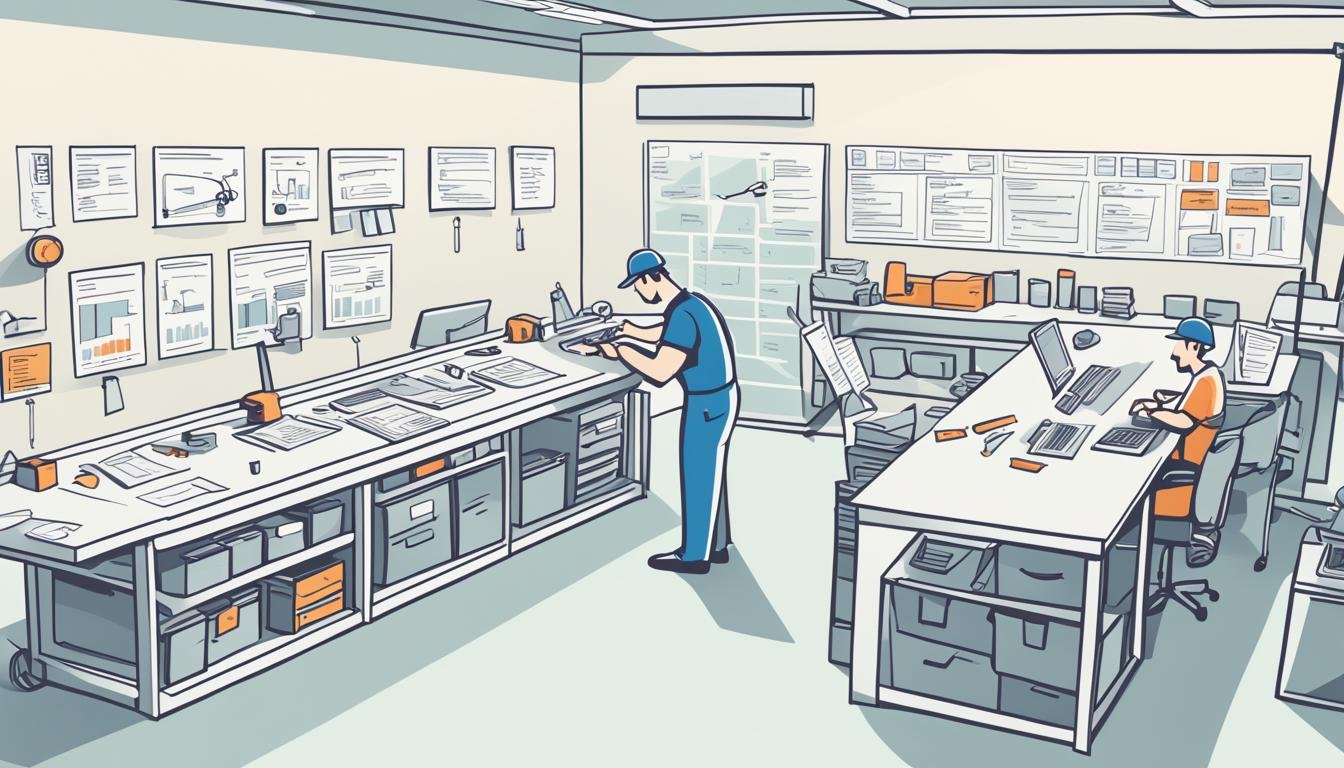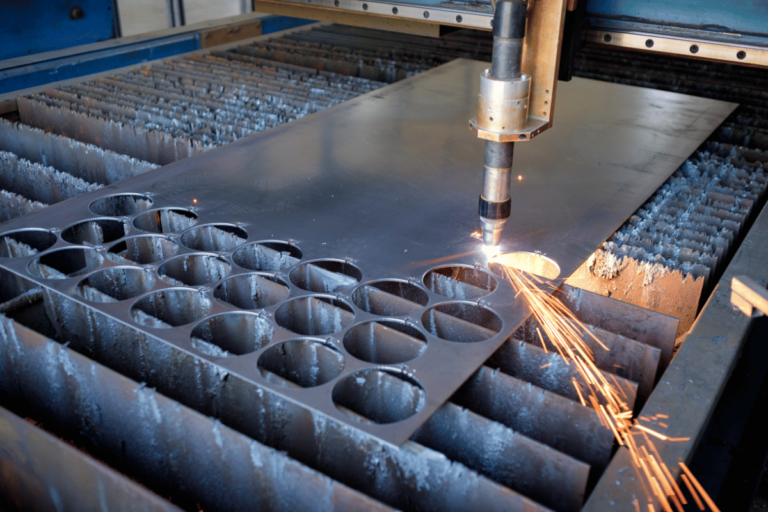Reducing Waste with Lean Manufacturing Tools
Did you know the 5S System is a key lean manufacturing method? It has five main parts: Sort, Straighten, Shine, Standardize, and Sustain. These steps help get rid of waste and make processes less heavy, pushing companies towards better production methods. Tools like these are vital for boosting efficiency and profits in today’s competitive world.
The goal of lean manufacturing is to make operations smoother, so every step adds value for the customer. Using strategies like Overall Equipment Effectiveness (OEE) and Kanban helps businesses track productivity loss and manage resources better. This leads to less unevenness in making things.
Tools like Value Stream Mapping and Business Process Management Platforms, such as HighGear, show the steps and activities in processes. They highlight where waste can be cut and how to improve operations. This approach focuses on fighting the Seven Deadly Wastes: making too much, waiting, moving items, having too much stock, unnecessary movement, doing too much work, and mistakes.
Using lean manufacturing tools and methods tackles these issues and encourages a culture of ongoing improvement. By focusing on what customers value and streamlining operations to remove bottlenecks, companies can make big steps in reducing waste in making things.
Key Takeaways
- The 5S System helps eliminate waste and overburden through five core components: Sort, Straighten, Shine, Standardize, and Sustain.
- Kanban and OEE are vital lean manufacturing tools that enable better workflow efficiency and productivity measurement.
- Value Stream Mapping visualizes process steps and helps identify wasteful activities in manufacturing.
- Business Process Management Platforms like HighGear enhance work management and workflow automation.
- Lean principles focus on defining value from the customer’s perspective and addressing the Seven Deadly Wastes.
- Continuous improvement is fundamental to achieving long-term efficiency and waste reduction in manufacturing.
Understanding Lean Manufacturing Principles
Lean manufacturing focuses on cutting waste and boosting efficiency in today’s production. These ideas come from the Toyota Production System (TPS) since the late 1980s. They aim to cut waste, improve quality, lower costs, and save time. By making processes better, companies can give more value to customers with less resources.
Value Stream Mapping
Value stream mapping is a key tool in lean manufacturing. It shows the flow of materials and info from making a product to the customer. By spotting what adds value and what doesn’t, companies can make their processes smoother. This helps them understand what customers want and improve their operations ahead of time.
5S Methodology
The 5S methodology is a big part of lean manufacturing. It’s about organizing and cleaning the workplace. The five steps – Sort, Set in order, Shine, Standardize, and Sustain – make sure everything has its place. This leads to a more efficient and less wasteful work environment, supporting a culture of ongoing improvement.
Just-in-Time Production
Just-in-time production is key to lean manufacturing. It matches production with customer demand in real time, cutting down on lead times and inventory. This method makes sure each step in production happens when it’s needed, reducing waste and using resources better.
Key Lean Tools for Waste Reduction
Lean manufacturing offers powerful tools for reducing waste. These tools help improve processes, increase productivity, and cut waste. They also support continuous improvement.
Kaizen Events
Kaizen means “continuous improvement” in Lean Management. Kaizen Events are special sessions where teams work together to find ways to get better. They focus on different areas of the company.
- Identifying areas for enhancement
- Observing current processes
- Testing new methods
- Implementing the best practices
- Analyzing the outcomes for continual improvement
Visual Management
Visual management makes work clear and easy to see. It uses signs and symbols to highlight important info. This helps workers see how things are going and spot problems.
- Color-coding tools and equipment
- Using signage and labels for easy location of materials
- Tracking production progress through visual boards
Error-Proofing (Poka-Yoke)
Poka-Yoke, or error-proofing, stops mistakes before they happen. It makes sure processes and tools are designed to avoid errors. This Lean tool is key in making things better in manufacturing.
- Designing systems that prevent errors
- Ensuring immediate detection of anomalies
- Reducing the reliance on quality control inspections
Using Kaizen Events, visual management, and Poka-Yoke helps companies reduce waste and boost productivity. It also creates a culture of continuous improvement.
| Lean Tool | Key Benefits |
|---|---|
| Kaizen | Promotes continuous improvement and employee engagement |
| Visual Management | Enhances operational transparency and efficiency |
| Poka-Yoke | Eliminates defects and reduces the need for rework |
The Role of Continuous Improvement in Lean Manufacturing
Continuous improvement is key in lean manufacturing. It’s not just a goal, but a constant journey. This approach aims to cut waste in making things, focusing on what really adds value.
It means always learning and adapting. This comes from listening to customers, following best practices, and understanding your own processes.
Kaizen is a key idea in lean and continuous improvement. It’s about making small, steady changes for the better. By focusing on eliminating waste, lean makes things more efficient.
This leads to better equipment use and overall process improvement. It’s all about making things run smoother and more effectively.
Tools like Root Cause Analysis and the Plan-Do-Check-Act cycle help fix problems at their source. This makes processes simpler and quality better. It also cuts down on time and boosts productivity.
The Five Principles of Lean guide us. They focus on adding value, cutting unnecessary steps, and making processes better. Digital tools help by giving real-time data and improving communication, making things more agile.
Improving continuously in lean manufacturing is easy and cost-effective. It doesn’t need complex formulas or processes. This makes it easy for plants to get better at making things and using resources well.
By having everyone work towards constant improvement, companies can aim for excellence. This reduces waste and increases value, making things better for everyone.
Conclusion
The fight against waste in manufacturing is a well-thought-out effort. It uses a strong lean strategic framework. By learning about lean manufacturing, like Value Stream Mapping and 5S Methodology, companies can cut down on waste.
Lean manufacturing focuses on making things better and adding value for customers. It helps companies tackle waste, including too much production and mistakes. It also looks at hidden wastes like unused talent and bad habits. By using these strategies, companies can grow sustainably, work more efficiently, and stay ahead in the market.
Improving things bit by bit is key to success and growth. Look at Toyota Motor Company and others who lead the way. They use lean manufacturing to make better products, save money, and empower their workers. This approach to managing waste is crucial for any company aiming for long-term growth and top performance in today’s industry.
Source Links
- Lean Manufacturing Tools and Techniques
- Essence of Lean – Eliminating Waste (Muda)
- What is Lean Manufacturing and the 5 Principles Used?
- Understanding Lean Manufacturing | KAIZEN Article
- Lean Manufacturing Tools and Techniques
- Lean Tools and Principles and Their Applications
- Top 10 Lean Tools for Continuous Improvement – MJV Innovation
- Continuous Improvement in Lean Manufacturing – Lean Process Improvement
- Driving Waste Reduction: Powering Lean Manufacturing Continuous Improvement
- 9 Wastes of Lean Manufacturing
- Introduction to Lean Waste and Lean Tools
- Lean Manufacturing: Reduce Waste, Improve Efficiency







